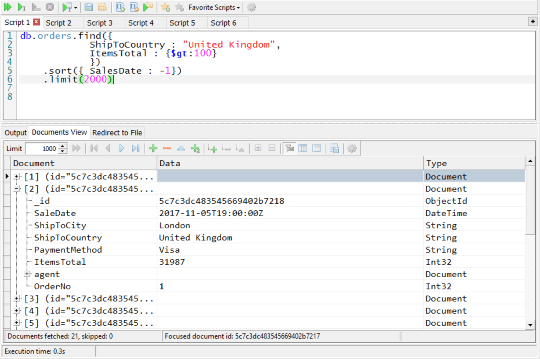
No guarantee is given for reading consistency while querying against DynamoDB's global secondary indexes. Read operations are configured to return strongly consistent data, which adds latency and doubles the cost of the read. Read queries are routed to secondary replicas falling under the allowed limits of the primary server with the help of secondary consistency controls.ĭynamoDB is eventually consistent by default. If needed, read operations consistency can be relaxed. It supports multi-record ACID transactions and allows just 25 write operations.īy default, MongoDB is strongly consistent because all the read/write operations are present in primary in a MongoDB replica set, scaled across several partitions (shards). DynamoDB indexes are provisioned individually from the underlying tables, which leads to some unforeseen issues at runtime. Users can define up to 5 LSIs and 20 GSIs per table. It supports two types of indexes: local secondary indexes (LSIs) and Global secondary indexes (GSIs). For queries requiring graph traversals, aggregations, or search, additional tools such as Redshift or Elastic MapReduce are used, which increases latency, cost, and developer work. MongoDB can take up to 1000 operations in a single transaction.ĭynamoDB supports key-value only. It also supports multi-document transactions and combines the ACID guarantees of traditional relational databases. As a result, users can avoid the latency due to syncing data between the analytical and operational engine. MongoDB's query language allows developers to build applications whose data can be analyzed and queried in several ways, such as single keys, faceted search, ranges, graph travels, geospatial queries, and JOINs without using any additional tools. Also, DynamoDB does not have native data validation capabilities. DynamoDB supports limited data types, resulting in application complexity and minimizes the scope of data re-use across different applications. Also, a record/item cannot exceed 400KB in size.

As a result, Database administrators can apply data governance standards, and developers can easily maintain a flexible document model's benefits.ĭynamoDB stores data in a key-value format and supports JSON to provide document-like data structures to match objects in application code. Users can check the document structure, data types, presence of mandatory fields, and data ranges. MongoDB also provides built-in schema validation. A MongoDB document can go up to a size of 16 MB with GridFS, more massive data sets can be natively stored within the database. MongoDB stores the data in the JSON-like format called BSON and supports multiple data types, including dates, timestamps, 64-bit integers, & Decimal128. In contrast to this, DynamoDB is available only on Amazon Web Services (AWS). MongoDB can run anywhere from a laptop to an on-premise data center to a public cloud environment. MongoDB vs DynamoDB - Which is Better? #1. It allows you to offload the administrative burdens of operating a distributed database without worrying about hardware provisioning, replication, cluster scaling along with setup and configuration. What is DynamoDB?Īmazon DynamoDB is a NoSQL databases service that offers seamless scalability with faster performance. A document is a basic unit of data in MongoDB and consists of key-value pairs. Collections contain sets of documents and functions, which is the equivalent of relational database tables. It makes use of collections and documents, unlike traditional relational databases, which make use of tables and rows.

MongoDB is a document-oriented NoSQL database used for high volume data storage. The following topics will be covered in this MongoDB vs DynamoDB:ģ.

MongoDB vs DynamoDB - 6 Basic Comparisons In this article, we have enlightened the essential aspects of MongoDB vs DynamoDB which will help you understand both MongoDB and DynamoDB. Here, you would learn about the two most popular NoSQL databases - MongoDB and Amazon DynamoDB. They also facilitate real-time application modifications, faster application development and require less administrative overhead. NoSQL databases manage volumes of structured, semi-structured, and unstructured data and require no predefined schema. The growth of big data has spurred the need for NoSQL databases to deliver better cloud performance. One of the crucial decisions that an enterprise has to make while moving to the cloud is to select the right type of database that supports their business. Organizations are switching to the cloud environment to ease business operations and management.


 0 kommentar(er)
0 kommentar(er)
